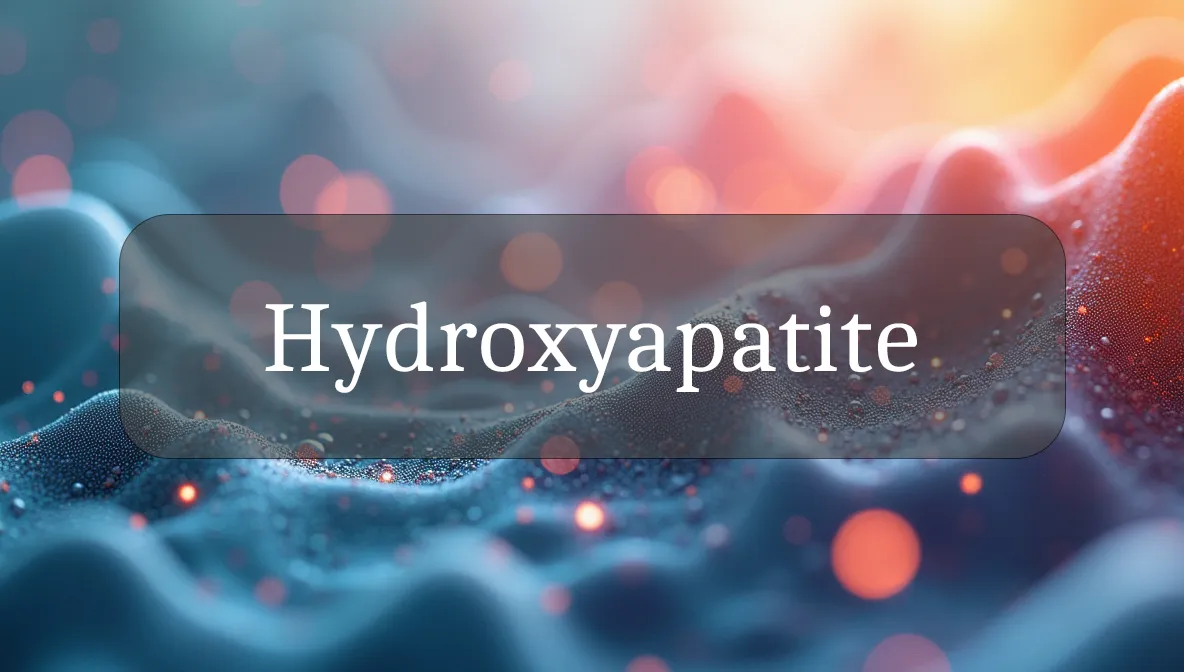Mineral Foundation for Strong Bones and Teeth
Hydroxyapatite is like your body’s natural building block, a mineral that forms the core of your bones and teeth, giving them strength and durability. As a key component of your skeletal system, it’s vital for health-conscious folks aiming to maintain resilience and vitality. Understanding hydroxyapatite can empower you to make choices that support your bone health and overall wellness. Let’s explore what hydroxyapatite is, why it matters, and how you can nurture its function for daily vitality!
Chemical Identity and Type
Hydroxyapatite is a naturally occurring mineral, a calcium phosphate compound with the chemical formula Ca₁₀(PO₄)₆(OH)₂. It’s the primary inorganic component of bone and tooth enamel, forming a crystalline lattice that provides hardness and stability. Produced by osteoblasts (bone-forming cells), hydroxyapatite integrates with collagen to create a strong, flexible matrix. Think of it as the steel reinforcement in your body’s skeletal concrete, ensuring structural integrity.
Biological Role and Benefits
Hydroxyapatite is a cornerstone of your skeletal and dental health, offering these benefits:
- Bone Strength: It provides rigidity to bones, supporting weight-bearing and reducing fracture risk.
- Tooth Durability: Hydroxyapatite forms the bulk of tooth enamel and dentin, protecting against decay and wear.
- Tissue Repair: It supports bone remodeling and healing, aiding recovery from fractures or injuries.
- Mineral Reservoir: Hydroxyapatite stores calcium and phosphate, releasing them as needed for blood balance and cellular functions.
- Joint Support: By strengthening bones, it indirectly stabilizes joints, enhancing mobility and comfort.
Healthy hydroxyapatite levels keep your skeleton robust, teeth resilient, and body balanced, enhancing overall vitality.
Dietary or Natural Sources
Your body synthesizes hydroxyapatite using calcium, phosphorus, and other nutrients, so you don’t get it directly from food. Support its formation with these nutrient-rich choices:
- Calcium-Rich Foods: Milk, yogurt, cheese, leafy greens (kale, broccoli), and fortified plant milks provide calcium, a key hydroxyapatite component.
- Phosphorus-Rich Foods: Fish (salmon, sardines), eggs, nuts, and legumes supply phosphorus for hydroxyapatite synthesis.
- Vitamin D Sources: Fatty fish, egg yolks, or sunlight exposure (10–30 minutes daily) enhance calcium absorption, aiding hydroxyapatite formation.
- Magnesium-Rich Foods: Almonds, spinach, and whole grains support bone mineralization and hydroxyapatite stability.
A balanced diet with adequate calcium and phosphorus fuels hydroxyapatite production.
Signs of Imbalance or Dysfunction
Reduced hydroxyapatite formation or loss (due to aging, nutrient deficiencies, or disease) may show up as:
- Bone Weakness: Increased fracture risk, osteoporosis, or bone pain.
- Tooth Decay: Weak enamel, cavities, or sensitivity due to enamel erosion.
- Joint Issues: Instability or discomfort from weakened bone support.
- Slow Healing: Delayed recovery from fractures or dental procedures.
- Fatigue or Muscle Cramps: Low calcium availability from bone stores, affecting nerve and muscle function.
These symptoms can have many causes, so if they persist, consult a healthcare provider to explore bone or dental health issues.
Supporting Optimal Levels or Function
To enhance hydroxyapatite formation and maintenance, try these evidence-based tips:
- Eat Bone-Building Foods: Include dairy, fish, or greens to provide calcium, phosphorus, and vitamin D for hydroxyapatite synthesis.
- Exercise Regularly: Weight-bearing activities like walking, running, or strength training stimulate bone cells to deposit hydroxyapatite.
- Get Sunlight: Moderate sun exposure (10–30 minutes several times a week) boosts vitamin D, supporting calcium absorption for hydroxyapatite.
- Avoid Bone Stressors: Limit excessive soda (high in phosphoric acid) or smoking, which can disrupt calcium balance and weaken hydroxyapatite.
- Prioritize Sleep: Aim for 7–9 hours of quality sleep to support bone remodeling and mineral deposition.
Small, consistent habits create a bone-friendly environment for hydroxyapatite to thrive.
Safety, Interactions, and Precautions
Hydroxyapatite is a natural mineral and safe when balanced, but consider these factors:
- Nutrient Imbalances: Excessive calcium or phosphorus supplements can lead to soft tissue calcification or kidney issues. Use under medical guidance.
- Medical Conditions: Osteoporosis, kidney disease, or hyperparathyroidism can disrupt hydroxyapatite formation, requiring professional management.
- Medications: Drugs like bisphosphonates (for osteoporosis) or corticosteroids may affect hydroxyapatite turnover. Discuss with your doctor.
- Dental Products: Hydroxyapatite-based toothpastes are safe and effective for enamel repair but consult a dentist for persistent dental issues.
Protecting hydroxyapatite balance means supporting bone and dental health with balanced nutrition and lifestyle.
Fun Fact
Did you know hydroxyapatite makes up about 70% of your bones and 97% of your tooth enamel? Its crystal structure is so tough that it’s even used in medical implants to mimic natural bone!
Citations
- National Institutes of Health (NIH): Calcium, Phosphorus, and Bone Health.
- Mayo Clinic: Osteoporosis and Bone Mineralization.
- Cleveland Clinic: Nutrition and Skeletal Wellness.
- World Health Organization (WHO): Diet and Bone Health Guidelines.
- USDA: Dietary Guidelines for Americans – Calcium-Rich Diets.

